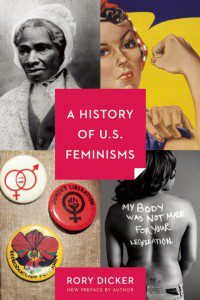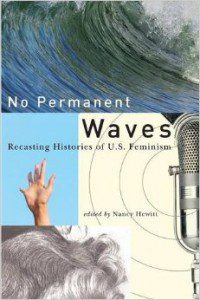What do we do when the President-elect of the United States is a bully and a serial liar, who has fanned the flames of racism, anti-Semitism, misogyny, and Islamophobia in our country? My first impulse as a progressive religious leader was to reaffirm that regardless of this or any other election, the congregation I serve will continue to be in solidarity with Muslims, women, refugees, people of color, and people with disabilities. We will continue to advocate for the equal rights of Lesbians, Gay, Bisexual, Transgender, Queer and Questioning citizens of this county.
Hillary Clinton’s candidacy inspired me to read A History of U.S. Feminisms, and in the wake of her defeat, I take some  solace in the wave-like pattern of the feminist movement in our country. There are no permanent waves. But when a wave crashes, another begins the process of rising up again.
solace in the wave-like pattern of the feminist movement in our country. There are no permanent waves. But when a wave crashes, another begins the process of rising up again.
Historians have named three periods, or “waves” of feminism in describing the cresting and crashing waves of gendered protest and backlash that have brought us to this present moment. The first wave of the women’s movement in the U.S. began to rise almost 170 years ago, in 1848 in Seneca Falls, New York, with the first women’s rights convention. That first wave crested ninety-six years ago in 1920 with the passage of the Nineteenth Amendment to the Constitution: “The right of citizens of the United States to vote shall not be denied or abridged by the United States or by any State on account of sex” (Dicker 6). There’s a wonderful story that when:
“Tennessee became the thirty-sixth and final state to ratify the Nineteenth Amendment, the final and deciding vote in Tennessee belonged to twenty-four-year-old Harry Burns, who changed his vote after receiving a telegram from his mother reminding him to “be a good boy” and “vote for suffrage.” (54-55)
As an example of how long political waves can take to crest, only one of the original signers of the 1848 Declaration of Sentiments lived to see women win the right to vote in this country in 1920, but that 1848 groundwork was vital to the victory that came seven decades later (55).
After four decades of rebuilding, the second wave of the women’s movement began in the early 1960s, emerging alongside many other counter-cultural movements. And that wave grew in size and strength to achieve many successes including the passage of Title IX in 1972, which “prohibited sex discrimination in schools receiving federal funding” and created a sea change in athletic opportunities for girls and women (98). And 1973’s Supreme Court decision of Roe v. Wade advanced reproductive justice for women.
But despite these and other successes, second-wave feminism began tragically crashing with the slow death of the Equal Rights Amendment, which said: “Equality of rights under the law shall not be denied or abridged by the United States or by any state on account of sex.” Although the ERA passed the House of Representatives and the Senate to triumphant celebration in 1971 and 1972 respectively, it was ultimately defeated a decade later in 1982 when “North Carolina tabled the amendment and Florida and Illinois rejected it” (100).
After a backlash to the women’s movement in the 1980s, many historians date the resurgent third wave of the women’s movement to the rise in consciousness about sexual harassment triggered by law professor Anita Hill’s allegations against Supreme Court nominee Clarence Thomas in 1991 (103). The sexist way the all-male Senate Judiciary Committee treated Professor Hill inspired many women to run for Congress the next year, resulting in the election of five new female senators and twenty-four new women members in the House of Representatives (118). The second and third waves of the women’s movement have also become increasingly intersectional, embracing race, class, sexual orientation, and transgender perspectives. (The word intersectional uses the analogy of a traffic intersection in which oncoming traffic is coming from many different directions at once.)
 We’re still too close historically to declare an end to third wave feminism and/or a beginning to a fourth wave. But the more important point is that there are no permanent waves in any justice movement. As explored in the anthology, No Permanent Waves: Recasting Histories of U.S. Feminism, the wave metaphor also does not mean that “The decades excluded from the wave — before 1948 or from 1920 to 1960 — are feminist-free zones” (5). When a wave crashes, another begins the process of rising up again. Any surfer will tell you that as glorious as it is to ride a wave, you can’t continually spend all your time on top of a wave; that’s not how the ocean works.
We’re still too close historically to declare an end to third wave feminism and/or a beginning to a fourth wave. But the more important point is that there are no permanent waves in any justice movement. As explored in the anthology, No Permanent Waves: Recasting Histories of U.S. Feminism, the wave metaphor also does not mean that “The decades excluded from the wave — before 1948 or from 1920 to 1960 — are feminist-free zones” (5). When a wave crashes, another begins the process of rising up again. Any surfer will tell you that as glorious as it is to ride a wave, you can’t continually spend all your time on top of a wave; that’s not how the ocean works.
But in the words of my colleague, The Rev. Rebecca Gordon: “Our job is to keep scanning the horizon for the next wave. It will come.” And our call is the contribute to building that wave. We are in this together, and I am grateful to be on this journey with you.
For now, I’ll conclude with these words of support from my colleague The Rev. Ashley Horan:
You are enough, you are precious, your work and your life matter, and you are not alone. You are part of a “we,” a great cloud of witnesses living and dead who have insisted that this beautiful, broken world of ours is a blessing worthy of both deep gratitude and fierce protection. Whatever happens [in the wake of this or any other political election], our ancestors and our descendants are beckoning us, compelling us onward toward greater connection, greater compassion, greater commitment to one another and to the earth. Together, we are resilient and resourceful enough to say “yes” to that call, to make it our life’s work in a thousand different ways, knowing that we can do no other than bind ourselves more tightly together, and throw ourselves into the holy work of showing up, again and again, to be part of building that world of which we dream but which we have not yet seen.
The Rev. Dr. Carl Gregg is a trained spiritual director, a D.Min. graduate of San Francisco Theological Seminary, and the minister of the Unitarian Universalist Congregation of Frederick, Maryland. Follow him on Facebook (facebook.com/carlgregg) and Twitter (@carlgregg).
Learn more about Unitarian Universalism: http://www.uua.org/beliefs/principles












